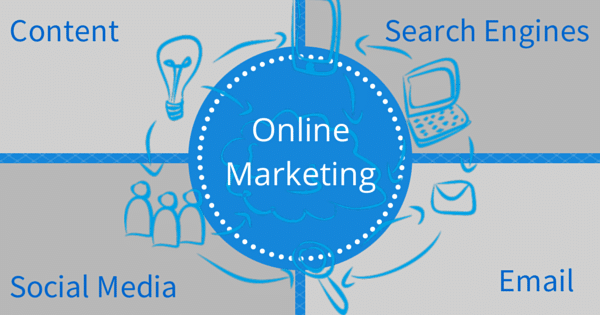
As 2014 comes to an end, it’s time to take a second look at your marketing strategy. Hopefully, you are already utilizing online marketing to generate leads through your website, but are you taking full advantage of all the tools and marketing methods available today? At Advantage Internet Marketing, we help our Maryland clients navigate the online marketing world and choose a marketing mix that best meets their business needs. Today, we’ll talk about different types of online marketing to give you a brief overview and a strategy behind each one.
Social Media Marketing
Although social media that presently dominate the scene have only been around for less than 10 years, they are widely used and highly influential. As of September 30, 2014, Facebook boasts 1.35 billion monthly active users, 17.8% of which are in U.S. and Canada. Like it or not, your customers use social networks, many on a daily basis, and this is another place you can reach them online.
Besides the social media giants like Twitter and Facebook, there are also plenty of niche social networks, such as Kaboodle for shoppers or Flixter for movie fans. Choose wisely where you spend your time—you can’t possibly have meaningful interactions with customers on all social networks. When marketing on social networks, it’s important to remember that, with a few exceptions, people don’t come there to shop or interact with brands. Respect the culture of the community you are joining and don’t sell-sell-sell all the time.
Email Marketing
Email is the preferred method of communication for millions of people these days, especially when it comes to purchases. Interestingly, while email was relatively new and fresh just ten years ago, it’s now being viewed as traditional means of communication versus the many emerging media, such as social networks.
Email marketing is about building your email lists of leads and nurturing them to become customers. Once they make the first purchase, the idea is to turn them into repeat customers and advocates for your business.
Search Engine Marketing
Search engine marketing (or search marketing for short) is the process of acquiring new leads and customers by improving visibility of your website in the search engines, such as Google, Bing and Yahoo. SEM includes both organic and paid strategies like search engine optimization, pay-per-click advertising (PPC) and conversion rate optimization.
As complicated as it sounds, SEM is a rather straightforward concept. The goal is to capture your potential customers as they search online for the products and services similar to yours. Because these people already have an intention to buy, you are getting more qualified leads. A very important part of SEM is having a website built to lead visitors through a sales funnel. Optimizing your pages with the right keywords might bring you traffic, but without a proper sales funnel this traffic won’t convert into paying customers.
Content Marketing
Content marketing is a relatively new tool in the marketing toolbox. Marketers have been using some forms of it for ages, but only recently has it become its own category and service. Content marketing involves creation and distribution of valuable and relevant content that aims to attract a specific audience. This content informs, educates or entertains without selling, which makes it a non-intrusive marketing strategy.
But how does content help you get customers, you may ask? Content is powerful in many ways—it can affect moods and even prompt behavioral changes. People may discover your business through the content you publish, they may share this content with their friends, form an opinion about your business or make a purchasing decision based on this content. And because you produce it, you control the message that is being distributed.
Inbound vs. Outbound Marketing
Most of the above online marketing strategies contain a combination of inbound and outbound marketing elements. In simple words, inbound marketing is about attracting customers organically and having them come to you, while outbound marketing focuses on getting your message in front of the customers, often interrupting their activities.
TV advertising and banner ads are good examples of outbound marketing, while content marketing is purely inbound. Because with inbound marketing people give you an implied permission to market to them, this type of marketing tends to be more effective than buying people’s attention with ads. However, there is a place for both in your marketing strategy.
Need help determining which new marketing tool to add to your mix in 2015? Get in touch and we’ll be happy to help by analyzing your current marketing activities and determining whether you are missing out on substantial internet traffic.
